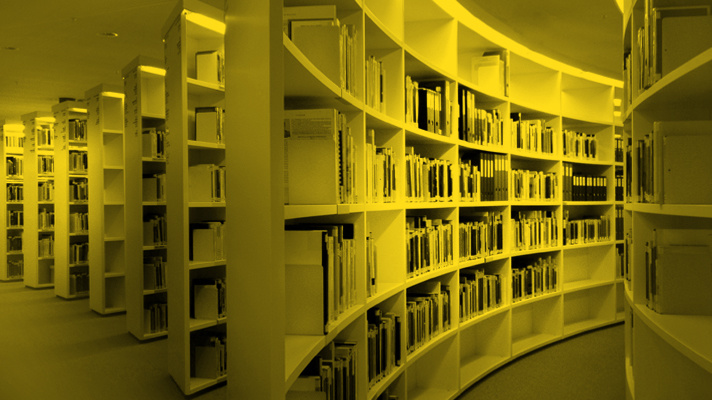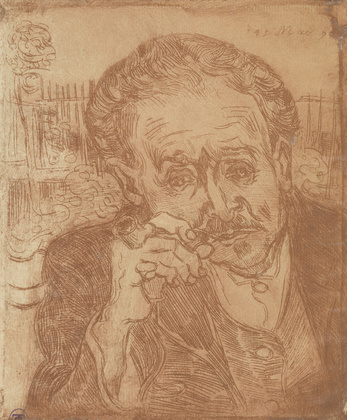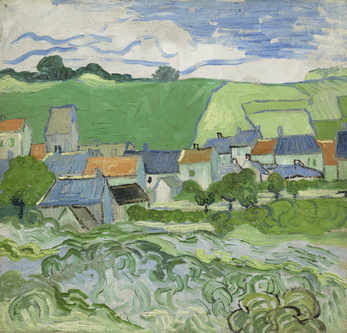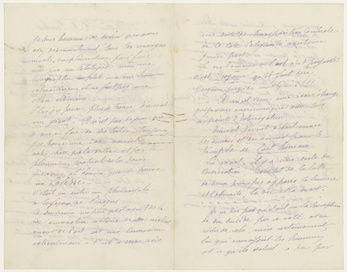
Documentation of this project
Van Gogh & collector Dr Gachet
 Vincent van Gogh (1853 - 1890) : Portrait of Doctor Gachet, June 1890, colour etching on paper, 30.6 x 23.6 cm
Vincent van Gogh (1853 - 1890) : Portrait of Doctor Gachet, June 1890, colour etching on paper, 30.6 x 23.6 cm Vincent van Gogh (1853 - 1890): Auvers-sur-Oise, May-June 1890, oil on canvas, 50.2 cm x 52.5 cm
Vincent van Gogh (1853 - 1890): Auvers-sur-Oise, May-June 1890, oil on canvas, 50.2 cm x 52.5 cm Letter of Paul Gachet sr. to Theo van Gogh, Auvers-sur-Oise, 15 August 1890
Letter of Paul Gachet sr. to Theo van Gogh, Auvers-sur-Oise, 15 August 1890“We cannot in any way rely on Doctor Gachet. Firstly, he is even more sick than am I, or so it seemed to me, or should we say at least as sick. So if a blind leads another blindman, will not both of them land up in the ditch?” Two months later Vincent van Gogh was dead and the role of the physician who treated him, Dr Paul Gachet, became the subject of fierce controversy. It thus seems all the more strange that the person of Dr Gachet has hardly ever been the subject of study, although he was a central figure in the last phase of Van Gogh’s life and in the dissemination of his legacy.
The physician also accepted artworks by way of payment for his services, as a result of which the Van Gogh Museum in Amsterdam has a collection of no less than 353 works (drawings, paintings, and prints) from Gachet’s circle. Together with more than 400 letters that the doctor and his son exchanged with Van Gogh’s family and descendants, they form the basis for the research by Associate Curator Sara Tas. In her project, for the first time she sets out to define the role of Dr Gachet as an agent and motivator. What influence did he have on the artists, and what on the works themselves, and in particular what influence did he have on Van Gogh?
As early as 1872, Dr Gachet had moved to Auvers-sur-Oise, a picturesque village on the northwest edge of Paris. From then on, he cared for patients in the capital and in Auvers. Since Gachet was himself part of the Parisian artworld (he exhibited at Salon des Indépendants, for example, and participated in prominent avant-garde events such as the Dîners du rouge et du bleu and the Dîners des Éclectiques), his home in Auvers soon became a port of call for artists. And they not only came as patients, but also in order to paint in the vicinity or, like Pissarro, Guillaumin, Cézanne, and later Van Gogh, to try their hand at his printing press under his supervision.
The time Van Gogh spent in Auvers was exceptionally productive, which can be attributed not least to Gachet’s influence, as the physician repeatedly encouraged him to create new works. Nevertheless, this last phase of his life is usually only mentioned in passing or reduced to its tragic end. However, this period in his work was defined by a quite unique style – it is no coincidence that to this day the “Portrait of Dr Gachet” is one of Van Gogh’s most famous pieces. On the occasion of the 170th anniversary of his birth and the Van Gogh Museum’s 50th jubilee year, the exhibition “Van Gogh & Auvers” is destined to give the general public a first-ever overview of this creative complex.
The research project thus fits into a larger exhibition context based on a closer look at the person of Dr Gachet. In order to be able to launch the exhibition, the Van Gogh Museum is cooperating with Paris’ Musée d’Orsay, which likewise has a hitherto unresearched archive on Dr Gachet. Using the treasure trove of material in both museums, Sara Tas is trying to highlight the still invisible but important patterns that attest to Gachet’s influence. To this end, for the first time the holdings are being entered in a database and carefully documented in order to render them accessible for the experts and the general public. The research findings lay the basis for an important part of the exhibition on “Van Gogh & Auvers”: a collection of prints that illustrate the role Gachet had in convincing members of the avant-garde to explore engraving.
Furthermore, the findings will be recorded in a scholarly article for the exhibition catalogue and in a lecture at a symposium, while also serving as the basis for a PhD thesis on Dr Paul Gachet to be submitted at Amsterdam University.
Project head
Emilie Gordenker
Institution
Van Gogh Museum Amsterdam
Support
The Gerda Henkel Foundation is supporting the project by granting a PhD scholarship and covering the costs of travel, materials, and personnel.
This project was documented in March 2022.

